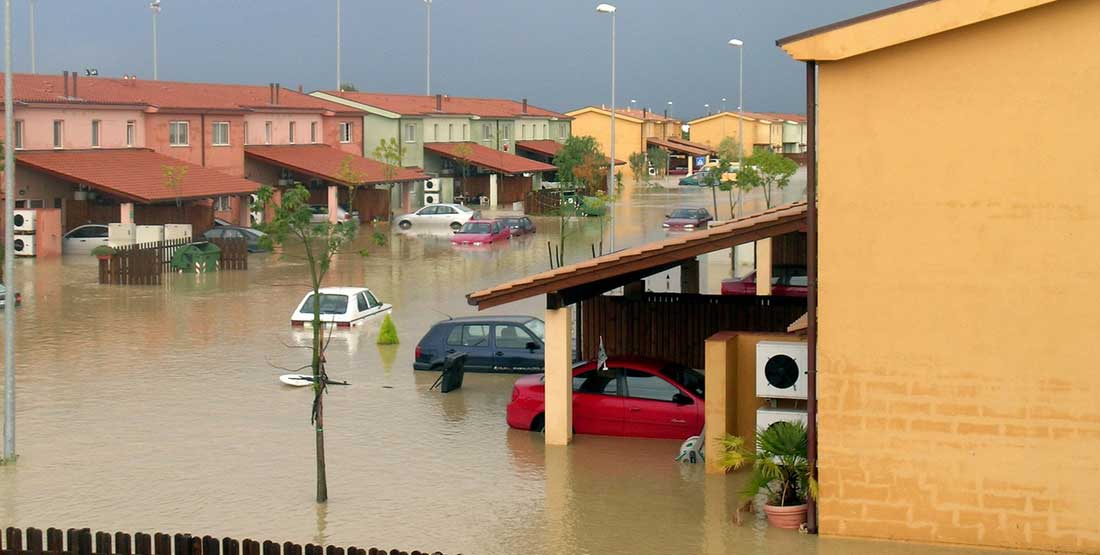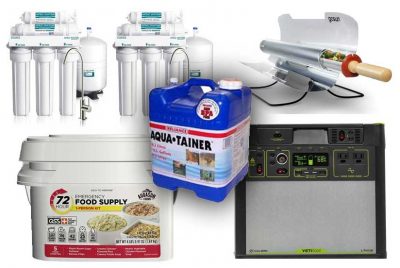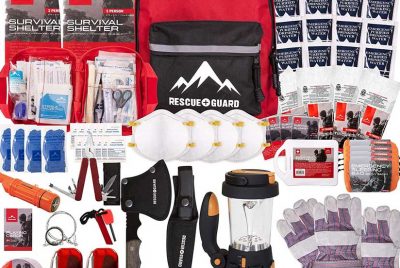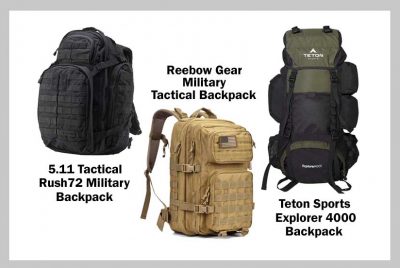There are lots of cheap prepper supplies that are great for building a beginner's survival kit.…
What is a Bug Out Bag?

If you’re just now getting into the survivalist mindset, and you’re researching survival gear, you may not have heard about the “bug out bag,” or “BOB” as it’s sometimes referred to. A bug out bag is simply a portable kit containing items that can help a person survive for the first three days (72 hours) after an emergency. However, some kits are designed to last longer than 72 hours. There are two main types; urban bug out bags and wilderness bug out bags. Depending on where you live, in a city location or a rural environment, your go bag will be packed a little bit differently.
This 72 hour emergency kit is most commonly referred to as a bug out bag. However, it is also referred to as a grab bag, get out of Dodge bag (GOOD bag), I’m never coming home bag (INCH bag), emergency relocation bag, or go bag to mention a few.
Whatever the problem, whether it’s a natural disaster such as a fire, flood, or earthquake, or another type of emergency that requires a sudden evacuation of your home, a bug out bag could possibly save your life as well as the lives of your family. But at the very least, it can make life a little bit easier during a difficult situation. It should also be noted that the purpose of the bug out bag is for sudden evacuation. It is not a survival kit intended for long-term survival.

Much of what goes onto your bug out bag list depends on an individual’s specific circumstances. Other items are considered universal, meaning they are important no matter what situation you find yourself in. It’s often impossible to know when a disaster or emergency will occur, so it’s always best to prepare before an emergency presents itself instead of scrambling after something unforeseen happens. Below is a list of items that are “must have” for any bug out bag.
1. Water is the Number One Must-Have for Your Bug Out Bag
Living without food for a few days may not be ideal, but it’s doable. However, living without water is something altogether more difficult. This is especially true in hot weather climates where dehydration can occur over a short period of time. One gallon of water per person per day is the recommended amount. Normally, half will be used for drinking and half for cooking and cleaning.
The whole idea behind the bug out bag is to help you survive for 72 hours. This means that three gallons of water per person is the minimum that belongs in your bag. However, it’s a good idea to add an extra gallon to your 72-hour emergency kit if possible. It should be noted that in some cases where families are concerned, it may not be possible to carry enough water for everyone due to the heavy weight of water. Some type of water filtration can usually solve that problem.
2. Food for Your 72-Hour Emergency Kit
It’s important to add enough food to a grab bag to last for three days. One of the best options is to use dehydrated meals. These are lightweight, easy to make, easy to prepare, and store well. Just use a freeze dryer to seal your food into airtight compartments. When it’s time for a meal, it’s a simple process of cutting a small slit across the top of one of the compartments where some boiling water can be poured in. Stir, then let sit for a few minutes, and it’s ready to eat.
Something even easier are pre-packaged dehydrated meals. Again, they’re lightweight, and are preferred over canned food. Plus, they take up very little space in your emergency relocation kit and can be stored for at least several months, assuming there aren’t any oils or fats in them. It’s also a good idea to replace them every few months. If they’re allowed to sit in your bug out bag for years, they may not be very satisfying. So every few months or so, eat the old ones and replace them with new ones. That way they’ll always be fresh if an emergency situation does arrive.
3. Water Filter (Water Purification)
So what happens if the emergency lasts longer than three days and you run out of water? A water filtration system can supply continued access to clean drinking water for you and your family. When you finish drinking your gallon jugs of water, don’t throw the empty containers away. Refill them with any water you can find using a pump water filter. It’s also possible to use an inverted bag filter or water purification tablets to accomplish the same thing.
4. First Aid Kit and Medications
Any decent bug out bag will include a good first aid kit. It is essential to include items such as band-aids, gauze and tape, antiseptic ointment or spray, and anything else you may need while you’re away from your home. Medicines for stomach aches, indigestion, nausea, and diarrhea are also recommended.
Depending on gender or other factors, additional items may be necessary to add to your emergency kit. Items such as Tampons, hand sanitizer, or medications that you or anyone else in your party is taking, should be included as well.
5. Shelter and Survival Clothing
Being protected from the weather is important. In most disaster or emergency situations a person will wear the same clothing for an extended period of time. However, adding extra socks and underwear to a bug out bag is a good idea. Other items such as gloves, poncho, hat, or umbrella can protect you against sun exposure or inclement weather.
Tarps are useful for creating shelter, but also for placing under sleeping bags and blankets to keep a person dry while sleeping outdoors. A tent would work just as well, but tents are heavier and not as versatile.
6. A Fire Starter is a Must for your Personal Emergency Kit
Fire can serve many useful purposes. It can keep you warm, cook your food, or boil water to use with dehydrated meals or to sanitize things. It may not become necessary to start a fire in some emergency situations, but if it is necessary, being able to start a fire will be greatly appreciated. Gathering dry wood and kindling will still be necessary, but a fire starter can make it so much easier to start a fire. Waterproof matches, a lighter, or a ferrocerium rod are all important items to add to your bag.

7. Flashlight
A waterproof flashlight is a must. Light sticks or emergency candles can provide low level lighting, but a trusty flashlight, with extra batteries, is one of the most important items in a 72-hour kit.
8. Knife
Every survivalist knows how important a knife is when disaster strikes. Knives are useful for preparing food (slitting open your dehydrated meals), making kindling for a fire, cutting rope, and many other things. You’ll want a good, sharp knife in your kit. And give yourself some bonus points if you also include a knife sharpener.
9. Compass
When you’re in a survival situation you may not have access to things like phones, maps and GPS systems. In an emergency it is always a good idea to have a detailed map of your area along with a compass, which can help you navigate with ease.
10. Survival Safety Equipment
In the event of a fire, chemical spill, or some other type of emergency that may make the air less safe to breathe, an air filtration mask can come in handy. Rope can be used to help hang a tarp, rappel down a mountain, strap tools to your backpack, hang food up high to keep it away from animals, and many other things.
Other items that are nice to have, but not absolutely necessary, are an external power-pack or small portable solar charger to keep your mobile phone charged, duct tape, mini shovel, ax, emergency whistle, pepper spray, firearms and ammunition, and trash bags. And last but not least, cash. It’s always a good idea to have a little extra cash for emergencies.
Summary
Packing the above-listed items in your survival bag is important. However, in your individual situation you may find that you can’t pack everything you need into one small backpack. This can be especially true if you have a dog. You certainly don’t want to leave your dog behind in an emergency, and yet, that dog will require food, water, and other essentials too. So what do you do? First, make sure you have a dog bug out bag or saddle bag so they can carry much of their own gear. And second, be sure to bring along some type of water filter or purification tablets because you’re not going to want to carry extra weight in the form of water.
Putting together a bug out bag is something everyone in your household should do. The ideal plan would be to have a bug out bag for each family member, as well as a box that includes additional food, water, and other optional items. That way, if you had to evacuate your home on foot, the bug out bags would be used. But if you were able to leave by vehicle, the box could be put into the vehicle as well.

Disaster can strike at any moment without notice, so get your bug out bag ready to go and make sure it’s in a place where it can be accessed no matter what type of emergency situation you find yourself in. And try to make sure it contains the survival supplies listed above, but most importantly water, food, first aid, survival clothing, fire starter, flashlight, and knife. And if you’ve got the storage space, you may want to fill up a box with some extra food and water, along with anything else you might want in an emergency that wouldn’t fit into a bug out bag.
Like this Article? Pin it on Pinterest




